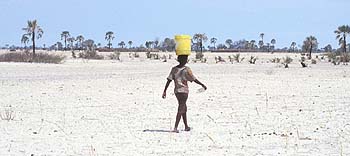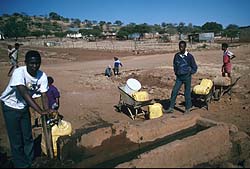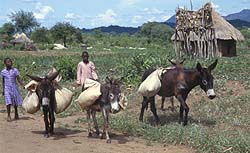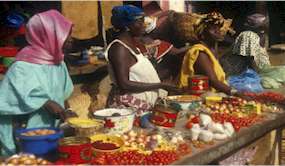|
|
|
Incorporating
non-transport solutions
|
| Some transport
and accessibility problems can be solved without intermediate means
of transport. Development planners and practitioners should consult
with rural communities and jointly identify solutions to transport
constraints. |
 Woman carrying water in Namibia, due
to
Woman carrying water in Namibia, due
to
the absence of a village well. |
Water transport is a major
problem in many communities. Water may be carried by people or by
using wheelbarrows, carts, cycles or pack animals. If water is piped
to houses, the transport of water ceases to be a domestic problem.
Similarly, the provision of additional wells or communal taps may
be more important to a community than the supply of water-carts.
|

Queuing for water
in South Africa |

Donkeys carrying
grains to grinding mill in Zimbabwe |
In Makete,
Tanzania, the introduction of piped water reduced household transport
requirements by 1400 person kilometres and 350 transport hours per
year. Village grinding mills saved another 100 transport hours per
household per year, women being the main beneficiaries.
|
| The problem
of transport of goods from village to market can be solved with intermediate
means of transport, such as carts or bicycles. An alternative solution
might be to establish a new market or depot in the village. Similarly,
increasing the number of schools and clinics can help solve the transport
problems of schoolchildren and the sick. Although intermediate means
of transport are useful in many different situations, they are not
a universal panacea. Sometimes transport problems can be addressed
through the combination of human walking/carrying and large-scale
transportation systems. |
|
 New market in Guinea
New market in Guinea |
|

